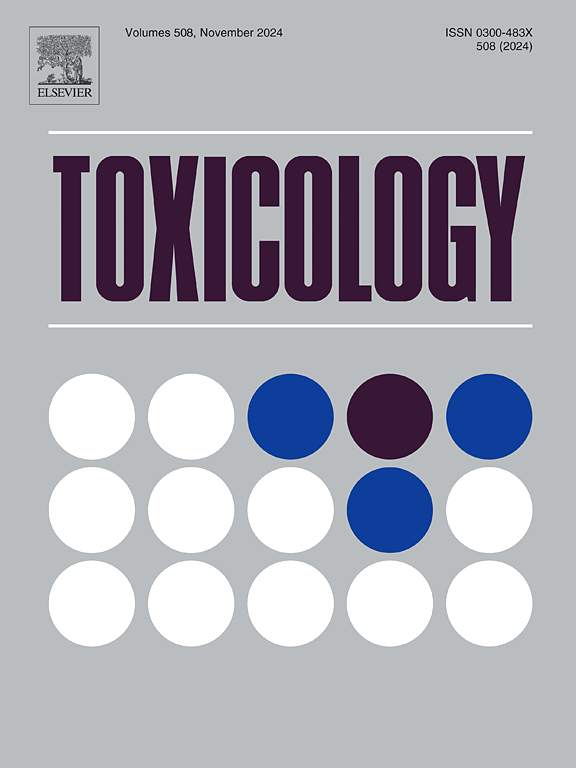Mitigation of PFAS toxicity through sorbent treatment in Sprague-Dawley rats during prenatal and postnatal exposure
IF 4.8
3区 医学
Q1 PHARMACOLOGY & PHARMACY
引用次数: 0
Abstract
PFAS (per- and polyfluoroalkyl substances) are prevalent and persistent environmental pollutants with significant toxicity, especially during critical windows of exposure such as pregnancy and lactation. This study investigated the prenatal and postnatal effects of PFAS exposure on the serum and liver of Sprague-Dawley rats, and the mitigating efficacy of orally administered sorbents. Animal groups included vehicle control, PFAS (0.95 mg/kg-bw/day), and PFAS co-treated with calcium montmorillonite (CM), CM-carnitine, CM-choline, activated carbon (AC), or acid processed montmorillonite (APM). Oral administration of PFAS resulted in accumulation in serum and liver by postnatal day (PND) 21, especially for PFOS. PFAS exposure also reduced body weight gain by 24 % in females and 35 % in males via reduced food and water conversion rates, impaired liver histopathological structure, caused hepatocellular hypertrophy, disrupted serum biochemistry, and reduced vitamins A and B2 in both sexes. Additionally, PFAS exposure increased oxidative stress and liver damage as evidenced by reduced antioxidants (GSH, SOD, GST), induced ALT, AST and pro-inflammatory cytokines (TGF-β and TNF-α), and suppressed CRP. Importantly, CM-carnitine and CM-choline were the most effective mitigating sorbents, significantly reducing PFAS bioavailability in the liver and serum and restoring biochemical parameters such as cholesterol, total protein, and glucose in serum. All sorbent treatments alleviated oxidative stress, normalized inflammatory markers, and improved nutrient levels in both serum and liver. Furthermore, the study revealed sex-specific responses, with females showing greater susceptibility to PFAS-induced metabolic changes and a more prominent response to sorbent mitigation. This study highlights the toxic effect of PFAS exposure in serum and liver during vulnerable windows of exposure such as pregnancy and lactation, and establishes the proof of concept for the oral administration of sorbents, particularly CM-carnitine, CM-choline, and a mixture of sorbents, as preventive mitigation strategies.
通过吸收剂治疗减轻Sprague-Dawley大鼠在产前和产后暴露期间的PFAS毒性
全氟烷基化合物(全氟烷基和多氟烷基物质)是普遍存在的持久性环境污染物,具有重大毒性,特别是在妊娠和哺乳期等关键暴露期。本研究探讨了PFAS暴露对Sprague-Dawley大鼠血清和肝脏的产前和产后影响,以及口服吸收剂的缓解作用。动物组包括车辆对照组、PFAS(0.95 mg/kg-bw/day)、PFAS与钙蒙脱土(CM)、CM-肉碱、CM-胆碱、活性炭(AC)或酸处理蒙脱土(APM)共处理。口服PFAS可在出生后第21天(PND)在血清和肝脏中积累,尤其是PFOS。PFAS暴露还通过降低食物和水的转化率、损害肝脏组织病理学结构、导致肝细胞肥大、破坏血清生化、减少两性维生素A和B2,使女性体重增加24% %,男性体重增加35% %。此外,PFAS暴露增加了氧化应激和肝损伤,证明了抗氧化剂(GSH, SOD, GST)减少,诱导ALT, AST和促炎细胞因子(TGF-β和TNF-α),以及抑制CRP。重要的是,cm -肉碱和cm -胆碱是最有效的缓解吸收剂,显著降低PFAS在肝脏和血清中的生物利用度,恢复血清中胆固醇、总蛋白和葡萄糖等生化参数。所有吸附剂治疗均可减轻氧化应激,使炎症标志物正常化,并改善血清和肝脏的营养水平。此外,该研究还揭示了性别特异性反应,女性对pfas诱导的代谢变化表现出更大的敏感性,对吸附剂减少的反应更为突出。本研究强调了PFAS暴露在血清和肝脏中的毒性作用,在暴露的脆弱窗口期,如妊娠期和哺乳期,并建立了口服吸收剂的概念证明,特别是cm -肉碱,cm -胆碱和吸收剂的混合物,作为预防缓解策略。
本文章由计算机程序翻译,如有差异,请以英文原文为准。
求助全文
约1分钟内获得全文
求助全文
来源期刊

Toxicology
医学-毒理学
CiteScore
7.80
自引率
4.40%
发文量
222
审稿时长
23 days
期刊介绍:
Toxicology is an international, peer-reviewed journal that publishes only the highest quality original scientific research and critical reviews describing hypothesis-based investigations into mechanisms of toxicity associated with exposures to xenobiotic chemicals, particularly as it relates to human health. In this respect "mechanisms" is defined on both the macro (e.g. physiological, biological, kinetic, species, sex, etc.) and molecular (genomic, transcriptomic, metabolic, etc.) scale. Emphasis is placed on findings that identify novel hazards and that can be extrapolated to exposures and mechanisms that are relevant to estimating human risk. Toxicology also publishes brief communications, personal commentaries and opinion articles, as well as concise expert reviews on contemporary topics. All research and review articles published in Toxicology are subject to rigorous peer review. Authors are asked to contact the Editor-in-Chief prior to submitting review articles or commentaries for consideration for publication in Toxicology.
 求助内容:
求助内容: 应助结果提醒方式:
应助结果提醒方式:


